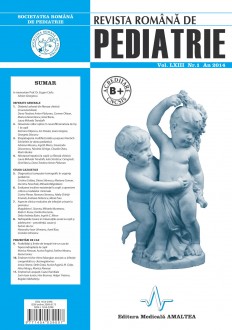SELECT ISSUE

Indexed

| |

|
|
|
| |
|
|
|

|
|
|
|
|
|
|
HIGHLIGHTS
National Awards “Science and Research”
NEW! RJP has announced the annually National Award for "Science and Research" for the best scientific articles published throughout the year in the official journal.
Read the Recommendations for the Conduct, Reporting, Editing, and Publication of Scholarly work in Medical Journals.
The published medical research literature is a global public good. Medical journal editors have a social responsibility to promote global health by publishing, whenever possible, research that furthers health worldwide.
LEOPARD SYNDROME. FAMILIAL CASES
Sorin Ioan Iurian, Han Brunner, Helger Yntema and Bogdan Mehedintu
ABSTRACT
LEOPARD syndrome is a complex disorder characterized by multiple dysmorphogenetic features. Both syndromes LEOPARD and Noonan are caused by different mutations in the same gene (PTPN11). Authors emphasize diagnosis peculiarities in two related cases with facial dysmorphism. Index case is represented by a 10 year-old boy admitted for evaluation because of cephalofacial dysmorphism associated with mental disabilities. Family history: non-consanguineous parents; the father’s case and his sister with face dysmorphism. Clinical exam: short stature, impaired nutritional status, axillary freckles, widespread café-au-lait spots, face dysmorphism, webbed neck, skeletal anomalies and mental retardation. Blood investigations and cardiac ultrasonography: no anomalies. Differential diagnosis includes Noonan syndrome, Greig syndrome, type 1 neurofibromatosis, Albright syndrome. Regarding patient genetic evaluation: normal karyotype; DNA sequencing revealed mutation in PTPN11 gene suggestive for LEOPARD syndrome. Authors also found same mutation for probant’s father. Conclusions. Authors described two cases with dysmorphic skull, skeletal anomalies, skin pigmentation, mental disabilities and short stature, justifying further genetic evaluation that revealed a very rare disorder.
Keywords: Leopard syndrome, child
